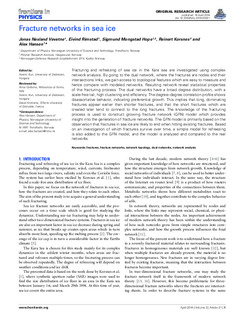| dc.contributor.author | Vevatne, Jonas Nesland | |
| dc.contributor.author | Rimstad, Eivind | |
| dc.contributor.author | Hope, Sigmund Mongstad | |
| dc.contributor.author | Korsnes, Reinert | |
| dc.contributor.author | Hansen, Alex | |
| dc.date.accessioned | 2015-09-22T12:04:06Z | |
| dc.date.accessioned | 2016-04-22T12:14:37Z | |
| dc.date.available | 2015-09-22T12:04:06Z | |
| dc.date.available | 2016-04-22T12:14:37Z | |
| dc.date.issued | 2014-04-16 | |
| dc.identifier.citation | Frontiers in Physics 2014, 2 | nb_NO |
| dc.identifier.issn | 2296-424X | |
| dc.identifier.uri | http://hdl.handle.net/11250/2387035 | |
| dc.description.abstract | Fracturing and refreezing of sea ice in the Kara sea are investigated using complex network analysis. By going to the dual network, where the fractures are nodes and their intersections links, we gain access to topological features which are easy to measure and hence compare with modeled networks. Resulting network reveal statistical properties of the fracturing process. The dual networks have a broad degree distribution, with a scale-free tail, high clustering and efficiency. The degree–degree correlation profile shows disassortative behavior, indicating preferential growth. This implies that long, dominating fractures appear earlier than shorter fractures, and that the short fractures which are created later tend to connect to the long fractures. The knowledge of the fracturing process is used to construct growing fracture network (GFN) model which provides insight into the generation of fracture networks. The GFN model is primarily based on the observation that fractures in sea ice are likely to end when hitting existing fractures. Based on an investigation of which fractures survive over time, a simple model for refreezing is also added to the GFN model, and the model is analyzed and compared to the real networks. | nb_NO |
| dc.language.iso | eng | nb_NO |
| dc.publisher | Frontiers Media | nb_NO |
| dc.rights | Navngivelse 3.0 Norge | * |
| dc.rights.uri | http://creativecommons.org/licenses/by/3.0/no/ | * |
| dc.title | Fracture networks in sea ice | nb_NO |
| dc.type | Journal article | nb_NO |
| dc.type | Peer reviewed | nb_NO |
| dc.date.updated | 2015-09-22T12:04:06Z | |
| dc.source.volume | 2 | nb_NO |
| dc.source.journal | Frontiers in Physics | nb_NO |
| dc.identifier.doi | 10.3389/fphy.2014.00021 | |
| dc.identifier.cristin | 1125668 | |
| dc.relation.project | Forsvarets forskningsinstitutt: 1141 | nb_NO |
| dc.description.localcode | Copyright © 2014 Vevatne, Rimstad, Hope, Korsnes and Hansen. This is an open-access article distributed under the terms of the Creative Commons Attribution License (CC BY). The use, distribution or reproduction in other forums is permitted, provided the original author(s) or licensor are credited and that the original publication in this journal is cited, in accordance with accepted academic practice. No use, distribution or reproduction is permitted which does not comply with these terms. | nb_NO |


